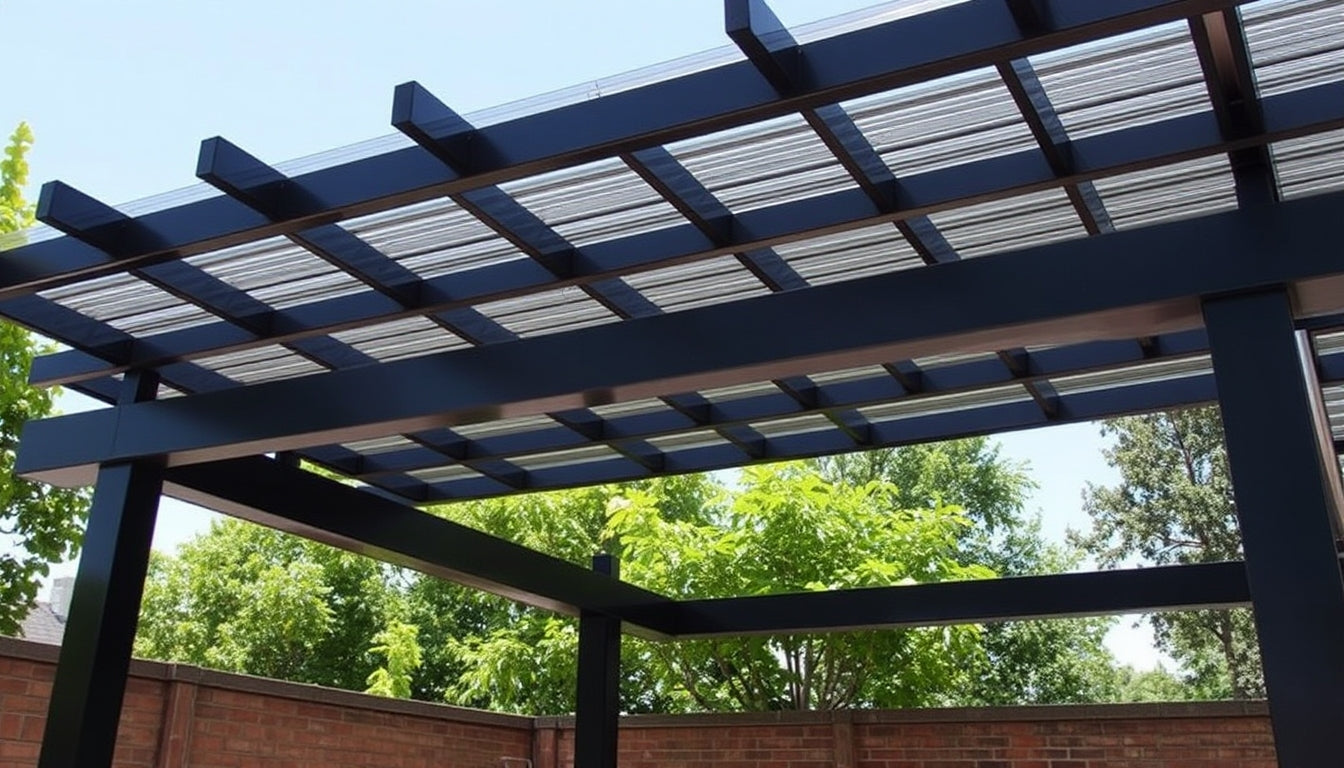A pergola can elevate any outdoor area, providing both shade and a stylish focal point. When it comes to roofing, metal has gained popularity for pergolas due to its unique benefits. This article delves into the advantages and disadvantages of a metal roof pergola, while also addressing design considerations, cost factors, and maintenance tips.
Advantages of a Metal Roof Pergola
1. Exceptional Durability
Metal roofs are renowned for their strength and long lifespan. Unlike wood, which may eventually succumb to rot or insect damage, metal is resilient against harsh weather, including heavy rain and strong winds. This durability means that a metal roof pergola can last for many years with little need for repair.
2. Minimal Maintenance
One of the most appealing aspects of metal roofing is its low maintenance requirements. Metal roofs resist issues like algae and mold, which means they don’t need to be cleaned as frequently. Occasional inspections are generally all that’s needed to keep the roof in good shape.
3. Aesthetic Versatility
Metal roofs come in various styles and colours, making it easy to find an option that complements your home’s architecture. Their sleek appearance can enhance the overall look of your outdoor space.
4. Energy Efficiency
Metal roofing can reflect solar heat, helping to keep your pergola cooler in warm weather. This feature not only creates a more comfortable outdoor environment but can also lead to lower cooling costs if the pergola is attached to a home.
5. Eco-Friendly Choice
Many metal roofs are made from recycled materials and are recyclable at the end of their lifespan, making them a sustainable option for environmentally-conscious homeowners.
Disadvantages of a Metal Roof Pergola
1. Higher Initial Costs
The upfront expense of installing a metal roof can be higher than other roofing materials like wood or fabric. While this cost can be offset by long-term durability and low maintenance, it might deter some homeowners.
2. Noise Issues
Metal roofs can produce more noise during rain or hail compared to other materials. While some people enjoy the sound, others may find it distracting. Using insulation can help reduce noise levels.
3. Heat Retention
Metal roofs can absorb heat from direct sunlight, potentially making the space underneath warmer. Adequate ventilation and shading solutions are important to manage this heat.
4. Expansion and Contraction
Metal expands and contracts with temperature changes, which can lead to warping if not properly installed. Ensuring expert installation can mitigate these risks.
Design Considerations
When planning a pergola with a metal roof, consider these design elements:
1. Structural Support
Since metal roofs are heavier than traditional materials, it’s crucial to ensure that the pergola’s structure is robust enough to support the weight. Reinforcements may be necessary.
2. Ventilation
Effective ventilation is essential for maintaining comfort and preventing moisture buildup. Designing openings or vents can enhance airflow.
3. Colour and Finish
Select a colour that harmonizes with your home and garden. Lighter shades can reflect more heat, while darker colours may provide a bolder look.
4. Landscaping Integration
Think about how the pergola will fit into your existing outdoor space. Incorporating climbing plants can soften the metal roof's appearance and create a welcoming atmosphere.
5. Lighting and Accessories
Plan for lighting options for evening use, and consider how to incorporate fans or heating elements for year-round enjoyment. Curtains or screens can also add privacy and functionality.
Cost Considerations
The cost of a metal roof pergola can vary based on several factors:
1. Material Quality
The quality of the metal, such as aluminum or galvanized steel, affects the overall cost. Higher-quality materials typically provide better durability and less need for repairs long-term.
2. Size and Complexity
Larger or more intricate designs will increase costs. Custom features and additional elements, while beautiful, contribute to the total expense.
3. Labor Costs
Hiring professionals for installation may increase costs, but it ensures that the pergola is built to last, benefits from expert wisdom, and adheres to safety standards.
4. Additional Features
Costs can rise with the inclusion of lighting, ventilation, or other accessories. Be sure to account for these in your budget.
Maintenance Tips
To keep your metal roof pergola in excellent condition, follow these maintenance tips:
1. Routine Inspections
Regularly check for signs of damage, rust, or loose panels. Early detection is key to preventing larger issues.
2. Cleaning
While metal roofs don’t require extensive cleaning, it's wise to remove leaves and debris regularly. A soft brush or low-pressure washer can be used for cleaning.
3. Rust Prevention
If rust is a concern, applying a protective coating or paint designed for metal can help prolong the life of the roof.
4. Fasteners and Seals
Inspect seals and fasteners periodically to ensure they remain secure. Loose components can lead to leaks or structural problems.
5. Clear Gutters
If your pergola has gutters or downspouts, keep them clear to prevent water buildup, which can damage the structure.
Conclusion
Opting for a metal roof pergola presents numerous benefits, including strength, minimal upkeep, and modern aesthetics. Wisely weigh these advantages against potential drawbacks such as noise and higher initial costs. By considering design features, budget implications, and maintenance practices, homeowners can make an informed choice that enhances their outdoor living area for years to come. With thoughtful planning, a metal roof pergola can transform any garden or patio into a stylish and functional retreat.


